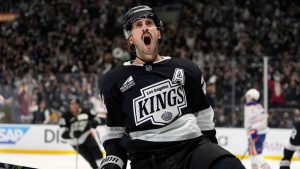Joe Thornton and Jason Spezza grew up in the era of wooden sticks and clutching-and-grabbing and the two-line pass.
You might be inclined to label the Toronto Maple Leafs teammates as dinosaurs because they’ve each got hockey memories and NHL experiences stretching back longer than some of the game’s young stars have walked this earth.
But the truth is they’re more like unicorns, and they’ve played a significant role in Toronto’s league-best .783 points percentage through 23 games.
[snippet id=5040828]
Consider what they share in common beyond wisdom, good humour and an avalanche of games played: Thornton and Spezza are both on a $700,000 contract, the minimum amount allowable under the terms of the collective bargaining agreement.
And they’re outperforming their twice-monthly pay cheques by a wide margin.
Of the 24 NHL players who have appeared in 10 or more games this season on a $700,000 contract, none have more goals (five), points (12) or points per hour (2.94) than Spezza. And none come close to matching Thornton’s points per game (.91), goals-for percentage (75 per cent) or Corsi-for percentage (57.9 per cent) in a year where he’s missed time with a rib fracture and undisclosed lower-body issue.
(Stats via puckpedia.com)
Scan a little further down the list and you’ll also find unheralded Travis Boyd among the players providing the Leafs an elevated return in exchange for the lowest NHL salary possible.
Collectively, they are the answer to a question that’s reverberated around this organization since well-publicized contract negotiations resulted in Auston Matthews, John Tavares, Mitch Marner and William Nylander signing big-money deals.
How do you win while paying your top-four forwards more than $40 million per year? In a hard-cap league, you absolutely must find value somewhere else.
Enter former NHL stars with deep ties to Toronto and contributions that extend beyond the intangibles. Thornton has held down a spot on the Leafs top line when healthy and both he and Spezza are regulars on the NHL’s second-most proficient power play. Spezza has also taken on a specialized penalty-killing role that’s seen him line up for more than three times as many faceoffs as any teammate in that game state and win an impressive 56.7 per cent of them.
On rival teams, those jobs are filled by depth players eating up a larger chunk of the salary cap. And in most cases they’re not getting the same level of performance for the extra allocation.
[snippet id=4167285]
Kyle Dubas was aggressive in pursuing Spezza during his free agency in 2019, setting up a sit-down meeting in the days before July 1 that helped establish the Leafs as front-runners. The veteran forward had other, more lucrative options elsewhere and wanted to win a Stanley Cup even more badly than he wanted to play for his hometown team. The conversations with the Leafs general manager convinced him he could actually do both.
"I thought it was a great opportunity and wanted to do whatever possible to make it work, knowing the team was going to have salary restraints and stuff," Spezza told Sportsnet during training camp in September 2019. "I was willing to kind of accommodate that and not get hung up over that."
He signed another one-year contract with Toronto a few weeks before Thornton took a similar plunge. The 41-year-old had options – both in San Jose and beyond – but chose the Leafs after some soul-searching and consulting a range of friends for advice, everyone from Joe Pavelski and Patrick Marleau to NFL Hall of Famer Joe Montana.
[relatedlinks]
Like Spezza, the family aspect was only a small part of what brought the St. Thomas, Ont., native to the Leafs.
"Really it’s because of the hockey team honestly," Thornton said after signing. "This team is a very, very good team and I need to win a Stanley Cup."
At the time, Dubas didn’t make it sound like there were any actual negotiations. He summed up the courting process like this: "We just kind of told him ‘this is what we have to offer and this is where we’re at."’
They had to sell a role, an opportunity and a vision while asking for a discount. That was the only way this roster could be filled out so effectively around the young stars because of the zero-sum game of NHL cap management.
There weren’t many other Thorntons or Spezzas out there to pursue if either signed elsewhere. The list of formerly elite players still burning to play – and still able to contribute – in the late stages of their careers isn’t particularly long.
It helps that they’re comfortable co-existing, too.
One of the first things Thornton got after signing with the Leafs was an invitation from Spezza to take his No. 19 sweater. Instead he went with the No. 97 that is currently one of the top sellers league-wide.
"I’m a FaceTime guy, so I like FaceTiming guys. Apparently he does, too, so he’s my kind of guy," Thornton said of Spezza. "He FaceTimed me and said ‘Hey man, do you want No. 19?’ I said ‘Nope. I’m not taking anything from you."’
Neither of them is taking very much from the Maple Leafs, in relative terms, and the team has become much stronger for it.




